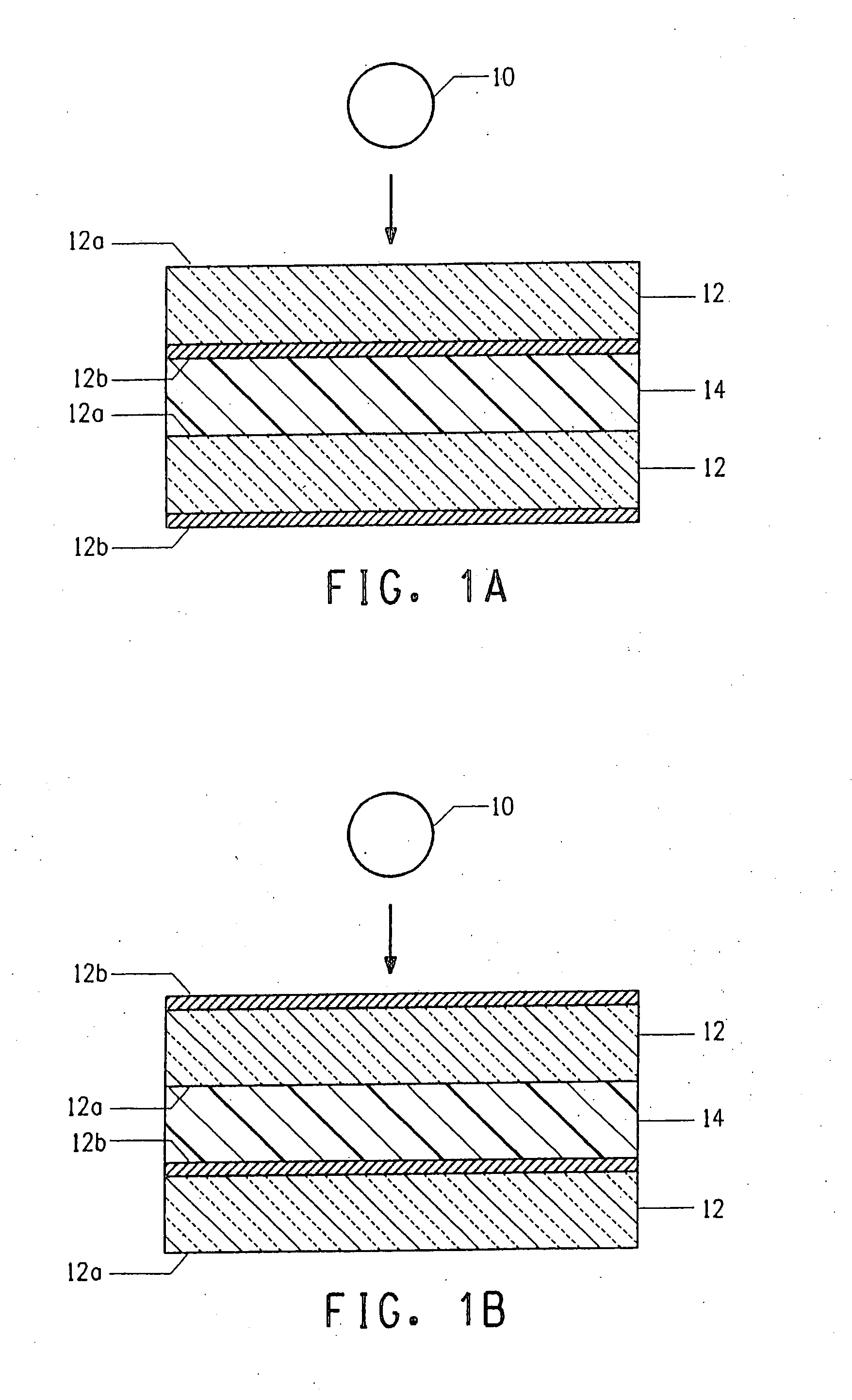Intrusion resistant safety glazings and solar cell modules
a technology of safety glazing and solar cell modules, applied in the direction of electrical equipment, packaging, synthetic resin layered products, etc., can solve the problems of reduced glass adhesion, not providing all of the safety aspects commonly associated with safety glass, and solar cell modules becoming much more complex
- Summary
- Abstract
- Description
- Claims
- Application Information
AI Technical Summary
Benefits of technology
Problems solved by technology
Method used
Image
Examples
examples
[0137]The solar cell interconnections are omitted from the examples below to clarify the structures; however, any solar cell interconnections that are known in the art may be utilized within the present invention.
Methods
[0138]The following methods are used in the Examples and Comparative Examples presented hereafter.
I. EN 356 P2A Test:
[0139]The polymeric sheets of the present invention were subjected to the modified EN 356 P2A test as described above. The number of laminate passing the test (a) out of the total number of laminate replicates tested (b) was reported as “a of b”.
II. Pummel Adhesion Test:
[0140]The pummel adhesion of the polymeric sheets was measured by the procedure disclosed in U.S. Pat. No. 5,618,863. Briefly, a portion of a laminate consisting of two outer glass layers bonded by a testing interlayer sheet, typically having dimensions of 15 by 30 cm, was subjected to the pummel test. First, this portion of the laminate was cooled for 8 hours at a temperature of −18° C...
examples 3-16
[0147]The 12-inch by 12-inch solar cell laminate structures described in Table 2, below, are assembled and laminated by Lamination Process 1, described above. Layers 1 and 2 constitute the incident layer of the solar cell laminate and Layers 4 and 5 constitute the back layer of the solar cell laminate. The structures of the solar cells of Examples 3 to 16 are also set forth in Table 2, below.
examples 17-30
[0148]Examples 17 to 30 have structures that are identical to those of Examples 3 to 16, respectively, as set forth in Table 2, below. They are assembled and laminated according to Lamination Process 2, above.
TABLE 2Solar Cell Laminate StructuresExampleLayer 1Layer 2Layer 3Layer 4Layer 5 3, 17Glass 1PVB(h)Solar Cell 1PVB(h)Glass1 4, 18Glass 2PVB(i)Solar Cell 2PVB(i)Glass2 5, 19Glass 1PVB(m)Solar Cell 3PVB(m)Glass2 6, 20Glass 1PVB(n)Solar Cell 4PVB(n)Glass2 7, 21FPFPVB(n)Solar Cell 1PVB nFPF 8, 22Glass 1PVB(h)Solar Cell 1Ionomer 1Glass3 9, 23FPFPVB(i)Solar Cell 4EBAAL10, 24Glass 1PVB(h)Solar Cell 1ACRAL11, 25Glass 2Ionomer 2Solar Cell 4PVB(i)AL12, 26FPFPVB(h)Solar Cell 1PVB(A)Glass213, 27FPFPVB(i)Solar Cell 4EMAFPF14, 28Glass 1PVB(m)Solar Cell 1PVB(m)AL15, 29Glass 1PVB(h)Solar Cell 2EVAGlass116, 30Glass 2PVB(i)Solar Cell 1PVBGlass2Notes for Table 2:ACR is a 20 mil (0.51 mm) thick embossed sheet of a poly(ethylene-co-methacrylic acid) comprising 15 wt % of polymerized residues of meth...
PUM
| Property | Measurement | Unit |
|---|---|---|
| Fraction | aaaaa | aaaaa |
| Pressure | aaaaa | aaaaa |
| Pressure | aaaaa | aaaaa |
Abstract
Description
Claims
Application Information
 Login to View More
Login to View More - R&D
- Intellectual Property
- Life Sciences
- Materials
- Tech Scout
- Unparalleled Data Quality
- Higher Quality Content
- 60% Fewer Hallucinations
Browse by: Latest US Patents, China's latest patents, Technical Efficacy Thesaurus, Application Domain, Technology Topic, Popular Technical Reports.
© 2025 PatSnap. All rights reserved.Legal|Privacy policy|Modern Slavery Act Transparency Statement|Sitemap|About US| Contact US: help@patsnap.com


